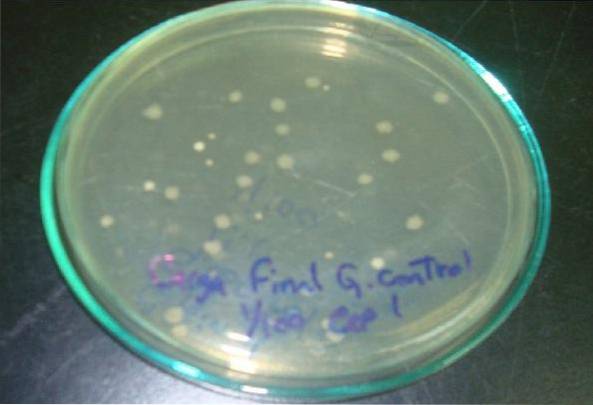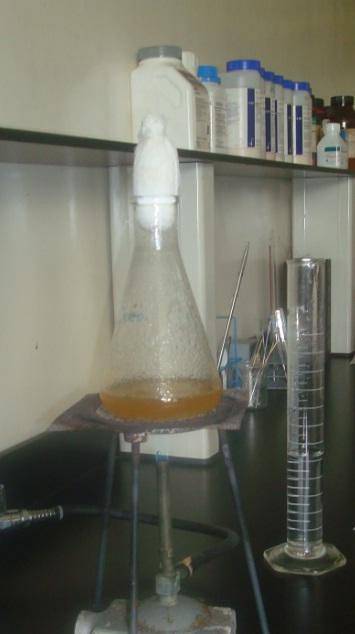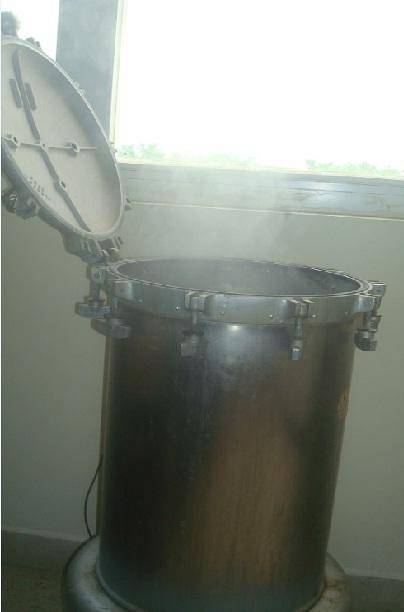
Nutrient agar foundation, preparation and uses
The nutrient agar It is a solid non-selective and non-differential culture medium. In this medium grow all kinds of bacteria that are not demanding from the nutritional point of view.
It is a simple medium and, despite its name, it contains a lower nutritional value compared to other similar mediums, such as Brain Heart Infusion Agar or Trypticase Soy Agar..

Its usefulness in the laboratory is very varied. Mainly used for species subculture, strain maintenance, colony counting, as a basis for preparing blood agar, among others..
Likewise, due to its light beige color, the production of pigments generated by some bacterial strains, such as the greenish pigment of Pseudomonas aeruginosa, the brick red pigment produced by Serratia marcescens at room temperature, the golden yellow pigment of Staphylococcus aureus, among others.
In addition, it is one of the cheapest growing media found on the market..
Article index
- 1 Rationale
- 2 Composition
- 3 Preparation
- 4 Uses
- 4.1 As a basis for the preparation of blood agar
- 4.2 Stimulate the sporulation of spore-forming bacteria
- 4.3 Strain maintenance
- 4.4 Colony count
- 4.5 Running diagnostic tests
- 4.6 Recovery of mesophilic aerobes from recreational salt waters (Beaches)
- 5 References
Basis
As already mentioned above, it is a very simple medium that is based on providing nutrients for bacterial growth without restriction and without complex reactions to interpret..
As the medium is translucent, it is ideal for counting colonies by the depth seeding method..
Composition
It is composed mainly of meat extract or yeast extract, peptones or gelatin pancreatic digest, agar-agar, sodium chloride and distilled water..
The meat or yeast extract and the peptones represent the essential sources of carbon and minerals (nitrogen, phosphorus and sulfur), which will be used by bacteria as a source of energy and growth factors..
Likewise, agar-agar is the base of all solid culture media, coming to replace gelatin, which was the first base compound used by Robert Koch to give solid consistency to his media..
Agar is a polysaccharide composed of galactose, galactomannan, agarose, and agaropectin. Sets at 40 ° C and melts close to 100 ° C.
For its part, sodium chloride provides the medium with the osmolarity necessary for bacterial development.
Finally, the water serves to hydrate and dissolve the lyophilized compounds. Distilled water adjusted to neutral pH should be used. Tap water should not be used because it contains calcium and magnesium that can react with phosphates in the medium and form insoluble salts..
Preparation
For one liter of nutrient agar, 31 g of the dehydrated medium must be weighed. Put it in a flask and dissolve in a liter of distilled water. After 5 minutes of standing, heat over a heat source and mix constantly until boiling for 1 or 2 minutes..

The flask is then placed in an autoclave and sterilized at 121 ° C for 20 minutes..

At the end of the time, it is removed from the autoclave and served in sterile Petri dishes, using a laminar flow hood or Bunsen burner..
If the Petri dishes are disposable (plastic), the medium must be distributed when the agar has a temperature of approximately 50 ° C, to prevent them from being deformed by excessive heat..
Allow to solidify and store on an inverted plate holder and refrigerate in a refrigerator at 2-8 ° C until use.
The plates must be tempered before being seeded. Nutrient agar plates should not be used if they are contaminated or dehydrated.
The pH of the prepared medium must be adjusted to 7.3 ± 0.2.
Applications
It is the simplest culture medium used in the microbiology laboratory. Its formulation is excellent for the growth of non-demanding bacteria.
Its main uses are explained below:
As a basis for the preparation of blood agar
This medium is sometimes used as a base to prepare blood agar, however it is not the most commonly used base..
Stimulate the sporulation of spore-forming bacteria
This culture medium is especially useful for stimulating the sporulation of spore-forming bacteria such as Bacillus sp.
To do this, a strain of the genus Bacillus and it is incubated for 24 hours at 37 ° C in aerobiosis. Once the colonies have grown, the plate is subjected to temperature stress, that is, the temperature of the oven is increased to 44 ° C and left for a further 24 hours or placed in a refrigerator for 24 hours.
At the end of the time, smears of the culture are made and stained with Gram stain or with Shaeffer-Fulton spore stain. In them, the bacilli with endospores (spores inside the bacillus) and exospores (spores outside the bacillus) will be observed..
Strain maintenance
Some research laboratories or university teaching support laboratories require maintaining viable bacteria of clinical importance for as long as possible, in order to use the bacteria bank (bacterioteca) for research work or for the preparation of teaching practices, where the students will learn to manipulate and identify these microorganisms.
Nutrient agar, as well as brain heart infusion agar, can be used for this purpose. The agar is prepared, poured into tubes with a bakelite lid and inclined on a base, in such a way that the agar solidifies forming a block at the bottom and a bevel on the surface (flute beak).
Each tube is labeled with the name of the bacteria to be seeded and the date. Each of the bacteria will be seeded on the bezel and incubated for 24 hours, once the colonies have grown, the tubes are stored at room temperature.
The bacterioteca must be renewed from 1 to 3 months, to avoid contamination and dehydration of the medium and as well as the death of the bacteria.
Only non-picky bacteria can be maintained in this way.
Colony count
Although there are specialized means for counting colonies, such as standard count agar, nutrient agar can be used for this purpose, either by surface seeding with a drigalski spatula or by depth. For this reason it is very useful in the microbiological analysis of food and water..
Running diagnostic tests
Because it is a medium that does not contain blood or any other additive, it is ideal for taking colonies grown on this medium to perform the catalase test..
Likewise, due to its light color it is indicated to carry out oxidase tests directly on an area of the agar seeded, without interference..
Recovery of mesophilic aerobes from recreational salt waters (Beaches)
The nutrient agar prepared with 10% seawater is useful for the evaluation of mesophilic aerobes in beach waters.
In this way, the real level of contamination that the waters have with these microorganisms can be appreciated, since in this type of samples the results are overlapped when culture media prepared in the conventional way are used..
This was demonstrated by Cortez et al. in 2013 in a research work.
This can be explained due to the abrupt change that bacteria undergo when going from a hypersalted environment to a low-salt environment, therefore the microorganisms enter a state of lethargy in which they are viable, but not cultivable..
References
- "Nutritive agar." Wikipedia, The Free Encyclopedia. 13 Sep 2016, 20:33 UTC. 29 Dec 2018, 21:04 en.wikipedia.org
- Forbes B, Sahm D, Weissfeld A. (2009). Bailey & Scott Microbiological Diagnosis. 12 ed. Argentina. Editorial Panamericana S.A.
- Koneman E, Allen S, Janda W, Schreckenberger P, Winn W. (2004). Microbiological Diagnosis. (5th ed.). Argentina, Editorial Panamericana S.A.
- Cortez J, Ruiz Y, Medina L, Valbuena O. Effect of culture media prepared with seawater on health indicators in marine waters of spas in Chichiriviche, Falcón state, Venezuela. Rev Soc Ven Microbiol 2013; 33: 122-128
- Paredes V, Dias V, Silva de Almeida M and Cardoso M. Microbiological quality of water for inseminating doses, for swine.Cient.Agro.Amaz. 2013; 1 (2): 42-49.
- García P, Paredes F, Fernández del Barrio M. (1994). Practical clinical microbiology. University of Cadiz, 2nd edition. UCA Publications Service.



Yet No Comments